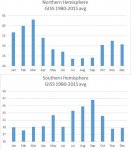- Joined
- Mar 31, 2013
- Messages
- 63,494
- Reaction score
- 28,835
- Gender
- Male
- Political Leaning
- Undisclosed
Oh please. Of course I know that. They don't use the same programs today that they used decades ago. Sheesh. That's why there's no contradiction.
The point was that the programs are written in order to support a conclusion. Every paper might use their own program. One additional problem is that too many use existing bad "data" from earlier research.
Again, when the guys who made that claim ran the data through their own 'improved' program, they got....a hockey stick.
See below.



